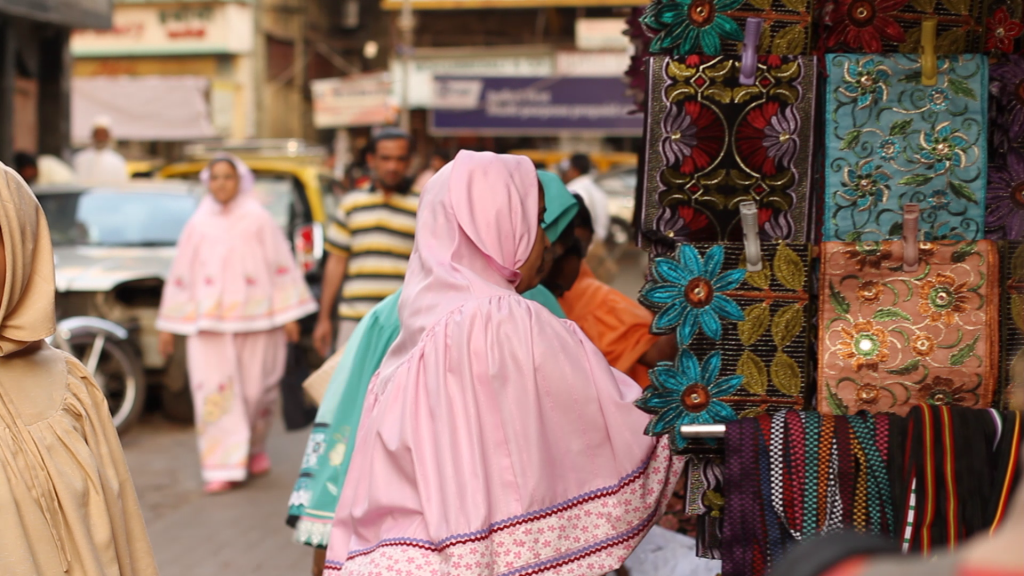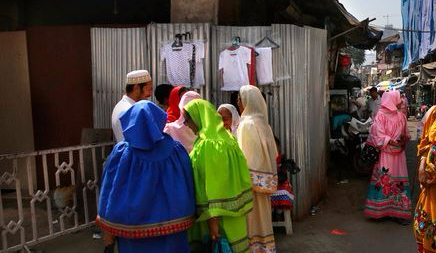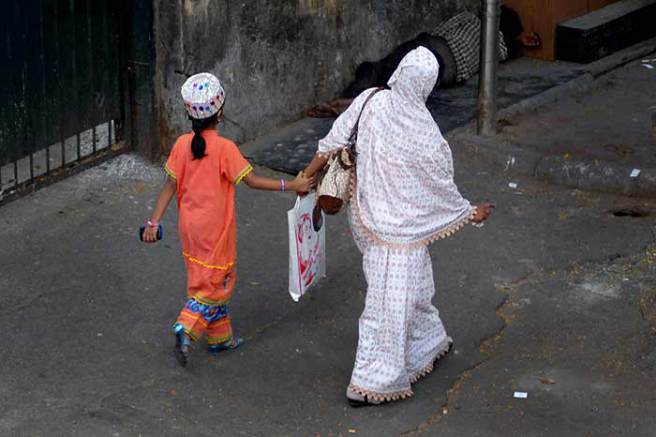Upcoming webinar: Exploring the connections between religion and female genital cutting

By Sarah Boudreau, Programs Intern Event: Exploring the Connections Between Religion and Female Genital Cutting Date: Thursday, October 28, 2021 Time: 2pm EST Registration Link: https://bit.ly/ReligionAndFGC On October 28, 2021, Sahiyo will be hosting a webinar, ‘Exploring the Connection Between Religion and Female Genital Cutting’ (FGC). This harmful practice is often attributed to certain religions or cultures. Some might say these acts are justified because they are tradition or holy, not to be argued by those outside of the community. But does religion alone truly perpetuate the practice of FGC? How do survivors of FGC view the topics of religion and spirituality? And how do these things affect them in their day-to-day lives as women? This virtual event will answer these questions and examine the FGC through a religious lens, including why it occurs and how it affects millions of women around the world. We will hear 3 expert speakers raise their voices while sharing insightful professional and personal experiences.The webinar will be moderated by Sahiyo U.S. Executive Director Mariya Taher and includes a panel discussion featuring Sameera Qureshi, Rahmah Abdulaleem, and more speakers to come. Register today and join us as we listen, learn, and advocate for change for the future. In addition, this webinar is part of a larger public awareness campaign that explores both connections and disconnections between religion and FGC, which Sahiyo will be initiating on October 28, in honor of the International Day of the Girl Child. When advocates speak about religion and its relationship with FGC, the conversation is usually focused on attempting to disprove the relationship and connection, rather than to uplift and highlight the idea that no religion should be permitted to promote harm to a child. This campaign will explore the major themes connecting religion and FGC, emphasizing how religion should never be used to cause harm, regardless of leadership or textual sayings. Our hope in creating this campaign is that we will educate the broader public on the right for women to choose and give consent, as well as the importance of agency over their own bodies. Speaker Bios: Sameera Qureshi, MS OTR, is an Occupational Therapist and Sexual Health Educator. For the last twelve years, Sameera has worked at the intersections of mental and sexual health education within Muslim communities, both in Canada and the United States. After twelve years in non-profit spaces, she founded her own business, Sexual Health for Muslims, in the Fall of 2020. The goal of her work is to create online, comprehensive sexual health education for Muslims, grounded in the tradition of Islamic spirituality and psychology. Sameera’s approach not only addresses the body and mind, but more so the soul, which is what Muslims are tasked with gaining self-awareness of. Apart from offering comprehensive, online sexual health courses for Muslims, she also provides one-on-one consultations, premarital education sessions, and regularly collaborates with Muslim organizations and other professionals in the field. Sameera also facilitates professional development opportunities for sexual and mental health providers who intersect and work with Muslim clients and communities. You can find her work on Instagram @sexualhealthformuslims, and on her website www.sexualhealthformuslims.com. Rahmah A. Abdulaleem is the Executive Director of KARAMAH: Muslim Women Lawyers for Human Rights. which aims to create a global network of advocates who are both knowledgeable about the gender-equitable principles of Islam, and are able to advance the cause of Muslim women’s rights in legal and social environments. Ms. Abdulaleem works with scholars to empower advocates about the rights Islamic law grants to women; she also educates Muslim women in Islamic jurisprudence, leadership, and conflict resolution so they may become the leading agents of change within their communities. Ms. Abdulaleem has coordinated and presented at educational and civil rights programs around the world. Ms. Abdulaleem obtained her J.D. from the University of Michigan Law School and worked at a top international corporate law firm for 14 years. You can learn more about her work on her website https://karamah.org.
Using purity as a means to control women through Christianity and female genital cutting

By Nicole Mitchell Many communities struggle to accept female sexuality even in today’s modern world. While it is common to see female sexuality in pop-culture, this doesn’t necessarily reflect a universal acceptance. Frequently, a woman’s value is tied to her “purity” or virginity. This prejudice manifests in obvious ways, such as female genital cutting (FGC), and in more subtle ways like teaching women and girls that their worth is tied to their abstinence. These methods of oppression are also not mutually exclusive and occur in many communities around the world including the Western, Christian community. Evangelical America I grew up as a minister’s daughter and one of eight children with five sisters and two brothers. My dad was a minister at an evangelical church in Boston, Massachusetts. While the evangelical movement is considered to be one of the more progressive, modern branches of Christianity, we still subscribed to such beliefs that a woman ought to be submissive to her husband by honoring him as head of the household, church and state. If you were to ask my dad and other fellow religious leaders their opinions on this now, they would probably avoid the question. Over the years, evangelical Christians have softened their voices, particularly in regard to the role of women and the LGBTQ community. This may be attributed to the growing resistance from millennials and younger generations against exclusive ideologies. As a young girl, I was taught that men and women had different, God-given strengths. Examples of female strength focused on traits such as empathy, caring and kindness, whereas male strengths included leadership, power and physical prowess. While men and women could embody both traits, such as being an empathetic leader — I was taught that a woman could never lead over a man. Essentially, the message was that women aren’t really leaders; they can just help organize other women. When I questioned this, I would often have scripture cited to me: “Let a woman learn quietly with all submissiveness. I do not permit a woman to teach or to exercise authority over a man; rather, she is to remain quiet” (1 Timothy 2:11-12). Even more blatantly, “Wives, submit to your own husbands, as to the Lord” (Ephesians 5:22-24). This belief was demonstrated in both my dad’s church I attended and in the larger, global ministry we were a part of, as there were no female head pastors. Women could be guest speakers during services, but never the head of the church. This idea that certain personality traits are reserved for specific genders, specifically leadership and power belonging to men, highlights a deeper division in how communities view a woman’s overall personhood and more specifically, her sexuality. The concept of a person being both spiritual and sexual was never discussed in my upbringing. As a woman, I felt that acknowledging sexuality or sexual desires was in direct conflict with being spiritual; one simply could not be both at the same time. Consummating a marriage was fine, but admitting to having sexual urges was considered not godly (i.e., Christian). Leaders and parents exhibited different attitudes in the way a boy versus a girl would be treated when admitting to participating in sexual acts or behavior. “Boys will be boys,” was the typical attitude when a young man admitted to sexual behavior before marriage. However, if a girl was promiscuous, within the church and my community, there was a substantial attitude of judgement toward her as if she was now deemed unclean, even sometimes suggesting that she was at fault for the boys “mistake” because of the clothes she wore or the way she carried herself. This wasn’t a direct principle preached in sermons; but it demonstrated the way purity and modesty were so heavily emphasized in my childhood. I know my brothers did not experience this emphasis, certainly not to the level I did. For example, every year my mom would take a few of my sisters and I to a women-only conference in New York called PureLife. Women from our global ministry would speak on a variety of topics with a focus on maintaining purity and a “clean spirit” with God. I remember the shame surrounding impurity was a heavy and distinct feeling. It is possible to surmise that when an idea is subtle or silent, it becomes more powerful because it is more difficult to challenge. This purity prejudice was further backed by scripture. One of the most fundamental stories in the Bible about Adam and Eve, instructs that mankind was doomed due to a woman pursuing knowledge. Eve’s interest in the tree of knowledge is portrayed as her ultimate downfall. Much like I would have been disgraced for exploring my sexuality at a young age, Eve was banished from heaven for pursuing knowledge according to the story. One could even surmise that the Bible is alluding to sexuality, not knowledge, given the level of shame Eve received. This idea that a woman should suppress her knowledge or sexuality is seen clearly in another important story in the Bible. The birth of Jesus Christ comes quite literally from a virgin mother. In theory, this teaches that the “ideal woman” would never explore her sexuality. After all, the “savior of the world” came from a “sexless” and “pure” woman. A woman pursuing her own sexuality or knowledge is not encouraged, but rather a sin. The Bible as it was written by men over time has a unique ability to reward submissive behavior, while inciting fear in women who might explore their own body. As a young Christian girl, it was clear my role model was to be Mary and not curious Eve. Again, while these principles were not overtly stated in the church, they were powerful, nonetheless. Female genital cutting The continuation of female genital cutting (FGC) in the modern world is further evidence of the oppressive undercurrent that defines a woman’s value based on her perceived purity. FGC is often practiced as a way to curb female sexual desires by preventing
Rejection of khatna must be a step in the liberation of Bohra women

By Zarina Patel Khatna, or female genital mutilation/cutting (FGM/C) within the Dawoodi Bohra community, is not a distinct or unique ritual. It has a context and it is important that Bohra women (and men) understand that context if they are to free themselves holistically, not only from the ritual itself, but from all that promotes it. Khatna is an imposition of a patriarchal system, a male-controlled system, that seeks to assign a gendered role or designated place for women and imposes rules and regulations to maintain these assigned roles. For women, that role is strictly within the family unit where her duty is first and foremost that of caring for her family, especially the husband or parents; giving birth, including ensuring the survival of humanity; nurturing the progeny; and upholding and promoting this culture and these customs which are largely defined by the patriarchs. No boy child has his destiny mapped out at birth within the Bohra community, but the idea of a girl child choosing and planning her destiny is considered as entirely secondary and trivial to her so-called God-given role. In this era of the internet and women’s liberation globally, it has seemingly become even more imperative for the patriarchs to keep their women (who, of course, they may consider as their property) in their place. Nothing works better than religious persuasion, but it so happens that nowhere in the Holy Quran is khatna mentioned, let alone made mandatory. So the patriarchs have concocted a variety of restrictions: women’s dress code is ordained for them; the baggy and unsightly rida is designed to make them feel ashamed of their bodies and to limit their movements; if women must work outside the home, it has to be in family circles or at most in a Bohra environment; if widowed, she must observe total seclusion for four months; associating or travelling with strangers is frowned upon, and so on. Khatna confers absolutely no benefit, medical or moral, to the girls who are cut. It can be traumatic with long-lasting effects both physical and psychological. It is one more such tradition, which at a very young age instills into the girl child that she is tainted and impure, and hence, it is normal for her to be violated and controlled. Is it surprising then that as adults, most Bohra women meekly accept the various restrictions placed on them. But women are the greatest defenders of the practice, we are told. True, very true – and some of those women are doctors and the like, educated, so to speak. Sahiyo has done, and is doing sterling work in exposing the harmful practice of khatna, and encouraging opposition to it. The rejection of khatna must be a step in the liberation of Bohra women.
Is the Dawoodi Bohra community truly as progressive as it claims to be?

By Saleha Country of Residence: CanadaAge: 45 Having lived in South-East Asia, and being exposed to multiple races and cultures, I grew up in a very open-minded family. As a child, my family and I occasionally went to the local Bohra mosque to socialize with others in the community. I loved going to the “masjid” – there I got a chance to meet my best friend and also eat delicious Bohri food. It was wonderful to see all the aunties dressed up in “onna ghagra” which are colourful skirts with matching chiffon scarves draped around the head. After the prayers, everyone congregated outside and chatted into the late hours of the night. Then suddenly in the early 90s it all changed. The upper echelons of the Bohra clergy instated new rules. The progressive Dawoodi Bohras were no more; instead, women were forced to wear a form of hijab called “rida” and men were made to sport a beard, wear a kurta, and “topi” or a cap on their heads. The clergy, headed by the Syedna, began to exert control over everything. Permission from Syedna was required not only for religious matters but in daily life as well. For example, permission was needed to start a business, get married or even to be buried. Female Genital Cutting or khatna was deemed necessary, even though that act of it is not prescribed in the Koran. If any of the rules were not followed, or if you protested and spoke against them, you were excommunicated or threatened to be. You’d lose all your ties to friends and family forever. I can never forget the awful day, when I was seven, while on a holiday in India, my aunt asked me to go shopping with her. She took me to a dingy place where a Bohri man and woman took me inside. They asked me to undress waist down, and when I protested, the man held my hands while the woman removed my jeans and underwear and forced me to lie down. I saw the man take out a blade and I struggled and screamed for help, while they proceeded to cut me. I lay bleeding on the floor, unable to comprehend what had happened to me. It was horrific, painful, and demeaning. I hated what was done to me. I hated that my mom was not there. I was angry at my aunt for allowing them to hurt me. I remember that experience vividly and to this day I am infuriated that I had to go through this ordeal as a child in the name of religion. While the majority of the Muslim communities around the world have spoken against this, the Dawoodi Bohra religious authorities urge continuing FGC under the guise of cleanliness. The worst part is that some women push this practise on vulnerable children too young to give consent, instead of protecting them as adults should. It was a difficult time for me. Having grown up with all the freedom in the world, it was suddenly being taken away from me and I grew cynical of my Bohra culture and wanted no part of it. Today, I am happy I decided to leave the fold. It was not hard to leave. In fact, it was liberating. I was not comfortable with the more rigorous path that my community was taking. I am sure there are many other Bohri people out there who are quietly questioning many of the beliefs handed down to them – some so silly, useless, and others very damaging – Bohris must refrain from using Western toilets; Bohris cannot host or attend wedding functions in secular, non-Bohra venues; brides can apply mehndi only an inch below the wrist and cannot hold the traditional “haldi” functions; and all Bohris must carry a RFID photo ID which will monitor attendance to the mosque. Humanity has achieved such remarkable progress. We have ventured into space, developed cloning and gene editing technologies, and most importantly, the Internet has resulted in globalization and interconnection between various cultures and communities. In this light, I wonder why we are still talking about FGC and the right to choose to do it to our daughters in this day and age? I am thankful that organizations like Sahiyo and We Speak Out have become a voice for children who are being hurt in the name of religion. I look at my children and I see the most informed, connected, and progressive generation. Imposing impractical, harmful religious rules such as continuing FGM on such a generation will only drive them further from our culture. More and more Bohri women and men are speaking out against this harmful practise because whenever religion becomes too rigid, too corrupt, it begins to crack. My hope is that our community can find the strength to break free from all the rigid practices and once again become the most progressive community among the Muslims.
Female Genital Cutting (FGC): Is it an Islamic Practice? (Part 2)

By Debangana Chatterjee Though often being referred to as an Islamic practice, Female Genital Cutting (FGC) precedes both Islam and Christianity. It is believed to have originated in the Pharaonic era of Egypt. Elizabeth Boyle, author of Female Genital Cutting: Cultural Conflict in the Global Community, mentions in the book that before the advent of Islam, Egyptians, who valued FGC (particularly infibulation), introduced a strong slave system and expanded it towards the adjacent geographic region. At the onset of Islam in the Egyptian controlled region, Islam asserted a stringent prohibition towards enslaving other Muslims. Hence, non-Muslim were continued to be used as slaves, and since FGC was done to these non-Muslim women slaves to increase their worth and value as slaves, FGC was by extension spread to other parts of Africa by the slave traders. This remains one of the driving factors behind the spread of FGC in Africa simultaneous to the rise of Islam. Despite FGC predating Islam, the myth of it being an Islamic practice persists due to the impressions of virginity and purity remaining closely associated with the religion’s values. There are ample reasons to challenge the unnecessary association of the practice with the Islamic culture. First, FGC was common among the Egyptian Coptic Christians and a number of Tanzanian Christian communities. In fact, FGC was also reportedly performed on Western women in the 1950s as a cure to nymphomania and depression according to L. Amede Obiora. Secondly, the practice is rife only among a limited number of Islamic practitioners of the world. Islam is the world’s second largest religion with approximately 1.6 billion followers of the religion consisting of 23.2 percent of the world population. On the other hand, there are around 200 million reported cases of FGC worldwide which includes non-Islamic people as well. Even if one takes these numbers as absolute, merely 12 percent (approx) of the entire Islamic population is affected by the practice. Thus, FGC does not necessarily qualify as an Islamic practice, considering most of the followers of the religion either nullify FGC or even remain oblivious to it. Third: the Holy Quran altogether stands in opposition to inflicting harm; going by that logic Islam cannot be supportive of FGC inflicting mental/physical harm of any sort onto women/girls. Despite the Prophet being explicit about sunna (tradition) on male genitals, FGC’s existence within Islam remains debatable. In many countries, Islamic traditions often remain debatable, including discussions on FGC. In the documentary The Cutting Tradition, an imam from the Harar region of Ethiopia is heard explaining how it already existed among various communities and the Prophet merely advised a sunna way of cutting where only the nicking of the clitoral prepuce is permitted. In the same documentary the Grand Mofti of Egypt, Fadilet Al-Mofti Ali Gomma repudiates any religious basis for FGM/C, though in 1994 a religious decree was issued in the country in favour of the practice stating it as an honourable deed for women. In fact, the decree, issued by one of Egypt’s prominent clerics Sheikh Gad el-Haqq, admittedly mentioned that FGC is not obligatory in Islam but should be followed due to the traditional rituals attached to it. Even in the Afar region of Ethiopia, religious leaders are seen invoking Islamic scripture and text to counter continuation of FGC among practicing community members. The practice came to South-East Asia in the 13th century, due to the advent of Islam in the region after the change in regime. The Shafi school of Sunni Islam in Indonesia and Malaysia considers FGC an Islamic practice, yet they are culturally influenced by the region where Yemen and Oman are situated, countries that have considerable FGC prevalence. At a time in the world when right-wing politics riles up with growing Islamophobia, it is important not to straightjacket Islam in order to avoid its unnecessary vilification and mindless demonization. Islam, as it grew, got entangled with cultural traditions in such a manner that it often looks inseparable. But a close and nuanced study of the matter opens it up for further scrutiny and leaves room for potential dialogic engagement with the communities practicing female genital cutting so that in time these communities will come to abandon it. Read Part 1 – What Islam says about Female Genital Cutting and how far are these texts invincible? More about Debangana Debangana is a doctoral scholar at the Centre for International Politics Organisation and Disarmament (CIPOD), Jawaharlal Nehru University. Through her research, she is trying to locate the existing Indian discourse surrounding the practices of FGM/C and Hijab into the frame of international politics. If you would like to connect with Debangana, you can reach her at debangana.1992@gmail.com.
Female Genital Mutilation/Cutting: Work of the devil?

By: Koen Van den BrandeAge: 56 Country: India I rarely speak of the devil. In Germany they have a saying: Du sollst den Teufel nicht an die Wand mahlenLiterally this translates to ‘Don’t paint a picture of the devil on the wall’. Loosely translated it means that you should not invite evil by talking about it. But maybe there are times we have a duty to alert others to the devil’s work. What I mean by that is not that anyone in particular is a devil but rather that maybe at times the devil has a hand in misleading people. My efforts to get to the bottom of the origins of the practice of ‘khatna’ – what the rest of the world calls ‘Female Genital Mutilation’ (FGM) – in the Suleimani community, recently led me to the inevitable conclusion that the devil has had a hand in twisting the words of the Prophet PBUH, to mean the opposite of what He was saying. My attention was drawn to some research carried out by learned members of the Muslim community. Let me present the facts to you so that you may come to your own conclusion. Early on in my own research I came across a Hadith – a reported saying of the Prophet – which was being quoted as evidence of tacit approval of this ancient practice, which predated Islam and may have been initiated in the distant past to subdue the sexual urges of female slaves. My discussions with members of the Suleimani community had made it clear that the Daim-ul-Islam is the rulebook to which many show an unquestioning allegiance. Of course such blind faith can have dire consequences. The Daim-ul-Islam does indeed refer to the Hadith in question. Following is an extract from a paper published on www.alislam.org, with the title ‘Female circumcision and its standing in Islamic law’. But it turns out this is not the full Hadith. In full, the Hadith seems to leave little doubt as to where the Prophet stood on this matter. The authors of the report quote from Al-Kafi, a respected Shiite book of traditions. Was the Prophet endorsing, encouraging or even mandating that women should be cut? Or was he signaling his disapproval and in the face of a long-established tradition, trying to limit the harm done to women? Given what he says, is it correct to claim, as some do, that he should have forbidden it, if he really felt it was wrong? I will leave it to you to draw your own conclusion. For me these words of Mohammed, now in full view, are consistent with other issues where he championed the rights of women in the face of a culture which at that time saw no reason to do so. Who decided to shorten the hadith and to what end? And at which point did a woman who ‘used to circumcise women slaves’ become a woman who ‘used to circumcise girls’? There is a substantive difference is there not? Just as with the modern day suggestion that Mohammed condoned wife-beating, when in fact he counseled restraint and suggested several alternative ways of resolving marital disputes or the insistence by some on the validity of ‘triple talaq’ divorce, where in fact careful mediation over a period of time is prescribed, one can only conclude that the devil himself has repeatedly sought to undermine the Prophet’s cause as champion of the rights of women! Today we call this ‘fake news’ and we are learning day by day, how it is used to mislead those who believe without questioning. Witness how the young parents of our community are systematically fed disinformation, building on that same principle of blind faith. But blind faith in whom? I quote from the website www.islamqa.com. Search for the term ‘khatna’ and the following question is addressed, among others: This is how the scene is set: I wonder what a properly qualified medical practitioner would make of some of the advice given. Need I say more ? How do we tackle such blatant attempts at misleading parents of young girls? Surely the best strategy must be to focus on facts and truth. So I am attempting to find a consensus across the Suleimani community around the following statement. “I as a member of the Suleimani Jamaat, in the interest of young parents and their girls, want to reflect what I believe to be the truth about the practice of khatna. Fact is … It is a tradition which predates Islam It is not mentioned in the Quran at all It is not practiced by all muslims It has been declared a crime in several Muslim majority countries It is considered a health hazard by the World Health Organization It is considered a crime against a child by the United Nations Truth is, in my humble opinion, that the Prophet Mohammed PBUH frowned upon this practice and sought to prevent harm from being done to women. I believe that these facts should be endorsed by our leadership and communicated to all of the Jamaat ‘s young parents. The Daim-ul-islam states that ‘khatna’ is not obligatory and that it should not be performed before a girl is 7-years-old. I believe that it would be in line with this rule to recommend to parents that any decision to proceed with this practice should be postponed until the age of consent. And in line with the Prophet’s guidance, at a time when it was a more common practice, I believe that when and if it is performed, it must be done symbolically only and cause no harm.” I hope you can join the effort by endorsing this statement. And if you cannot, I invite you to propose an alternative. At least let’s start by banning the use of http://www.isllamqa.com Let us work together to undo the work of the devil. This blog is the third in a three-part series that describes the practice of FGC within the Suleimani Bohra community.
What Islam says about Female Genital Cutting and how far are these texts invincible? (Part 1)

By Debangana Chatterjee A journey through religious texts helps us to validate or disprove the claims that there are religious justifications for traditional cultural practices. A similar logic applies to the claims that Female Genital Cutting (FGC) is an Islamic practice. The Holy Quran and the hadiths, evolving from the deeds of the Prophet Muhammad, form the basis of Sharia or the Islamic law. Whereas the Quranic scriptures are unquestionable, hadiths require authentication as they are the dynamic source of evolving Islamic practices. Hadiths are the Prophet’s verbal instructions which were documented by various narrators after the Prophet’s death. The actual narration of the text is called the matn and the insad contains the trail of narrators to support the authentic transmission of Prophet’s instructions over generations. Hadiths can be classified as either mutawatir or ahad. Mutawatir hadiths are substantiated and backed up by multiple reporters documenting his guidelines and thus, is adequately acknowledged within the Islamic circle. Praying namaz, donating, fasting and going for Hajj are few of the mutawatir hadiths which are considered fully authentic. On the contrary, although a few ahad hadiths are thought to permit a limited form of female genital cutting, they are deficient of authenticity borne through insad. According to a Baihaqi hadith, circumcision ennobles women. But many suggest it to be advisory rather than obligatory. One of the Bukhari Sharif hadiths considers circumcision as one of the acts of fitra (human acts inspired by God) like the removal of pubic hair, trimming the moustache, removing armpit hair and shortening nails. In Islam there has been much controversy whether fitra is binding. One Jami at-Trimidhi hadith suggests that there must be an essential bath after sexual intercourse between the two circumcised genitals of opposite gender. Though the supporters here take circumcision as a prerequisite to sexual intercourse and hence to marriage, the commandment of the hadith lies at the fact of taking a shower after sexual intercourse where circumcision may be spoken of as a natural presupposition. Written in Arabic, this hadith may have been toldto a community that was culturally inclined towards FGC at the time it was said. Hadiths by Abu Dawud, Al-Tabrani and Al-Khatib al-Baghdad seem to suggest conducting a plain cut of the clitoral prepuce, as according to them it beautifies a woman’s face and makes her even more desirable to her husband. Primarily even if the hadith indicates FGC, it eliminates the severe forms of it such as infibulation and only promotes the least severe form. Other interpretations of this hadith suggest that rather than taking it as the Prophet’s order, one may read this hadith as suggesting it is merely a desirable option. In contradiction, a hadith reported by Abu Sa’id al-Khudri and documented by Ibn Majah and Al-Daraqutni with an authenticated line of insad seems to unequivocally reject any practice amounting to harm. In Shia Islam, taharat (purity) concerning the notions of hygiene, cleanliness and purity is sometimes put forward to justify FGC. It is believed that due to the clitoral unhooding the excess building up of smegma is addressed. Yet, effective measures of washing and cleanliness are more than adequate to address this issue. Removal of healthy tissues for it does not seem to be credible enough. In India, Dawoodi Bohras, the largest Bohra sect belonging to the Tayyibi Ism’aili branch of Shia Islam, who practice khatna, consider the Da’i al-Mutlaq, also known as Da’i, to hold an authoritative, infallible status in the community. As the Da’i considers Daim-ul-Islam as the binding religious text for the Bohras, diktats of the text are taken as truth by devout community members. In this text, the Prophet is believed to advise for a simple cut of a woman’s clitoral skin as this, according to certain translations of the text, assigns chastity to a woman and makes her more ‘beloved by their husbands’. Though supporters of FGC cite this as the reason for the continuation of khatna, scholars have shown that da’is have never been as invincible historically, as has occurred in the recent past. In fact, changes in the provision that khatna is required, would add dynamism to the religion. Islam as a whole neither complies with the practice nor endorses FGC. Despite repeated invocation of religious references as a justification for FGC, considering the myriad number of Islamic texts, the grounds for such justification hold little or almost no merit. Read Part 2 – Female Genital Cutting (FGC): Is it an Islamic Practice? More about Debangana Debangana is a doctoral scholar at the Centre for International Politics Organisation and Disarmament (CIPOD), Jawaharlal Nehru University. Through her research, she is trying to locate the existing Indian discourse surrounding the practices of FGM/C and Hijab into the frame of international politics. If you would like to connect with Debangana, you can reach her at debangana.1992@gmail.com.
Let there be no more victims like me

By AnonymousCountry: Sri Lanka I am a victim of Female Genital Cutting – some might want to call it circumcision, I call it Mutilation. Not quite the way that the proponents want to depict it as what always happens in Africa (infibulation) with horrific scars, but in the way, it happened to me in Sri Lanka where there are still scars, tiny, almost unnoticeable. But in all the ways that matter, it has damaged me no less than the most severe forms of mutilation. To those who want to medicalize the procedure, let me say that I was cut by a qualified doctor, in a sterile environment, when I was seven-years-old. I remember that day clearly and it is I who have had to live with the consequence of what was done to me in the name of religion. Not my religious leaders, not my elders, and not that doctor. ME, the woman who that child without a voice grew up to be. Let me now take the arguments I’ve heard in support of the procedure and give you my perspective as someone who has first-hand experience of the negative impacts of FGC. I will use the term female genital cutting (FGC) since irrespective of what one wants to call it, that is what is done to a lesser or greater degree, depending on who holds the pin, blade or knife. A. Sex lives as Adults To the women who say that they have better sex lives due to FGC, I ask you this: what is your point of reference? Have you had sex with the same partner before and after your FGC to arrive at this conclusion? Have you ever considered the possibility that you have been very lucky, and that whoever performed the FGC on you spared you any real damage? It is also very presumptuous for you to assume that NONE of the billions of uncircumcised women around the world enjoy great sex the same as you. To the women who don’t have a horrific memory related to their own FGC and who don’t understand what all the fuss is about: let me tell you that neither do I. I don’t have any horrific memories of that day. My Mom who accompanied me held me gently, the doctor looked very professional and it was over before I knew what was being done. I felt a pinch, no bleeding that I can remember – just some cotton wool that smelled of antiseptic placed there after I was cut. And I walked out, confused, uncomfortable but definitely not traumatized. Sounds familiar? It wasn’t until I was as an adult that I realized the impact of what was done to me. I feel pain during intercourse. Most of you may not. But does that mean you are not damaged? Have you ever considered the fact that intercourse is supposed to be more than just “pleasant” or something you put up with when your husband feels so inclined? In my case, I have been examined by a doctor who has seen the tiny scars and helped me understand the impact of those scars on my ability to enjoy sex. Initially, I wondered whether what happened to me was a mere unfortunate mistake by this doctor. I have since then come across stories of others in Sri Lanka who were cut by the same and other doctors who share similar tales. So no, I was not an unfortunate accident – the doctor and others like him/her knew exactly what they were doing and did it nonetheless. B. The need to perform the procedure on a child All the literature shared by the supporters of this practice alludes to adult women enjoying their sex lives. However, I still have yet to come across any argument to support as to why the procedure needs to be performed on seven-year-old girls who have a long way to go before they begin their sex lives. So, what is being promoted is, in fact, the sexualizing of children. News flash: these organs don’t stay dormant and get activated only when one gets married. Personally, I find the very idea of parents allowing strangers to access to their daughter’s private parts for non-medical reasons and letting them alter her genitals, an extremely troubling thought. I’m more inclined to believe that in their hearts, they know that they are in fact desexualizing her. What they want in reality is to keep her pure and innocent until she could be given away. There is no thought given to the fact that she then has to live with a damaged body and fulfill marital obligations that she may not enjoy as much in their effort to keep her pure and innocent until she was given away. C. The Religious Argument Who decides on one’s religious belief? The individual or the individual’s parent? Yes, the parents would bring up the child within the religious norms they follow, and yes in most cases the child would continue with that belief till the end, but this is not always true for everyone. Hence, how do you justify altering a child’s body, without any medical reason, to be in alignment with the parents’ religious belief, when that child is yet to determine what path she would take or which God she will follow once she has learned enough to make that decision? As for me, I don’t believe that the God who created me required any man or woman to tamper with my body, with the assumption that they can make it better. I believe the Quran when it says that all of God’s creations are perfect. I won’t let any man or woman tell me otherwise. But my body has been altered irrevocably – it’s no longer the way God created it to be. My body is now in conflict with my religious beliefs. It has ended up representing the beliefs of others and not mine. The religious belief of others has also denied me
Not all damages are physical. Not everyone religious is morally ethical

Name: Xenobia (name changed) Age: 27Country: India Today, social media is raging with thoughts and opinions on empowering women, being pro-choice, violating someone’s privacy and their body, and the role of consent, among others. Some say rapists must undoubtedly be hung to death, while some talk about punishing molesters and eve-teasers as well, so that the right patterns are set at the grassroots level and so that they think twice before taking advantage of girls again. But what happens when the people taking advantage of a helpless 7-year-old girl are none other than her own family and community? Who, then, takes accountability for that? I’m not going to cry about my personal story here, but present some basic facts for you to consider. I am a Bohra Muslim raised in India. While the world sees us as a non-confrontational, peace-loving, business-thriving community, we have a secret tradition of circumcising 6-7-year-old girl children that we call khatna. There are plenty of arguments about how this is “needed” from a health point of view for males and how it helps them in their sex life eventually, but the most educated and civilised people agree that this practice is harmful to a woman’s physical, psychological and emotional health, especially since it is not supervised or is often performed by untrained aunties in basements. This practice is officially termed as “Female Genital Mutilation” (FGM) everywhere else in the world and it is increasingly treated as a crime committed on helpless female children. Why? What’s the reason? Some say purity, some say patriarchy. Some do it because it’s a mandatory tradition and if the priest says so, who dares to refuse? Some do it out of peer pressure, some do it to avoid being blacklisted or labelled rebellious. The popular conclusion for those seeking out answers has been, to moderate or curb a woman’s sexual desires. Sure, this might have worked well in an era when we lived in deserts and tribes were always on the lookout for stealing another’s woman. Irrespective of the reason today, does it even matter? However good your reasons may be, you still don’t have the right to decide what to do to a woman’s body without her consent. Whoever you may be. No matter what your intentions, the damage is done and you are still no different from a criminal. So what does this mean for the victims? The custom practiced by us is allegedly ‘Type 1’ and is different from that practiced by some African communities – Type 2 and Type 3 (based on levels of severity). As recognised by the World Health Organization, Type 1 FGC is described as the cutting of the clitoral hood and/or the clitoris, which poses a range of physical and emotional consequences such as infections, excessive bleeding, burning sensations while urinating, etc. The practice can adversely affect mental health as well since many young girls feel personally betrayed, helpless and confused. The child can also experience fear of sexual intimacy and mistrust of community members later in life as a result of the trauma. Sounds familiar? But aren’t there thousands of other women who have gone through the same thing, and claim they are not facing sexual problems? Just like most people don’t talk to others about what happens in their bedrooms, there are FGM survivors who don’t talk about their sex lives in public either. Some of them scream in pain through the night or are unable to have a healthy “bedroom life”. Plenty of these women are regular patients of doctors, sexologists, counsellors, and therapists. Yes, they manage to get pregnant (which is not very hard to do, with or without a man) but is the process peaceful and pain-free? No. Everyone talks about divorce rates going up but nobody realises why. They don’t see that in general, women are subject to a lot of curbing throughout their upbringing. Things have always been decided for them and whatever the gender might be, it’s not like we are brought up in a community that breeds leaders or independent decision makers. We are a herd of brainwashed followers. And with the recent #metoo revolution, women have just started discovering their voice. My personal take Yes, I was ‘cut’ too. I don’t remember the details, but I remember flashes. I was taken to meet “some aunty” and I remember not having a very good feeling about it, but you do what you’re asked to do anyway. We went to her gloomy house in Calcutta and she asked me to stand over an Indian-style toilet with my legs apart and I remember seeing blood fall. That’s all. I definitely remember having a hard time peeing for a week after that. Since this clearly does not qualify as a regular dinner conversation, it was just never spoken of after that. At age 16, I came across this ‘Muslim practice’ in Jean Sasson’s book – Princess. Among other terrible things done to women in Saudi Arabia, this was described in detail and that awoke something in my memory. At first, I was scared and terrified because I didn’t know what to do with that information. It didn’t make any sense. Why would something that awful be done to me? What was the purpose? Was this religious? Was this medical? Gradually, I started asking other people of my age about it. Thanks to the internet, I started understanding a lot more of this ‘barbaric’ practice and how it is just another side effect of our patriarchal world, where random men decide how we must lead our lives and what is good for us. What I couldn’t wrap my head around was how parents would let that happen to their own kids. When your daughter is at the peak of her innocence and brimming with nothing but pure love for you, you violate that basic trust. And then you actually hand her over to the monster who does that to her? So your religion asks you to
Tracing the Origins of Female Genital Cutting: How It All started

By Debangana Chatterjee Though the exact reason for the origin of Female Genital Cutting (FGC) is unknown due to the dearth of conclusive evidences, multiple theories revolve around how the practice began. FGC precedes both the start of Islam and Christianity and is practised predominantly because of cultural traditions. FGC is not limited to a single community, religion or ethnicity. Rosemarie Skaine mentions that there are archival documentations indicating a Greek papyrus to have recorded women to get circumcised while receiving dowries around approximately 163 BC. In fact, there are several Greek scholars mentioning its prevalence before the advent of Christianity. Broadly, the practice is believed to have originated in Egypt where circumcised and infibulated mummies were found according to Frank P. Hosken. Gradually, it spread around the contiguous areas of the Red Sea coast among the tribes through the Arabian traders. In Hanny Lightfoot-Klein’s opinion, though the practice is believed to first have spread in the form of infibulation, clitoridectomy increasingly became the more acceptable form of FGC. During the Pharaonic era, the Egyptians believed in gods having bisexual features. Elizabeth Boyle recounts that these features were believed to reflect upon the mortals, with women’s clitoris representing the masculine soul and men’s prepuce that of the feminine soul. Thus, circumcision was considered to be a marker of womanhood and a way to detach from her masculine soul. As it became a socio-cultural norm, FGC became the utmost criteria for women’s marriage, inheritance of property and social acceptance in ancient Egypt. Lightfoot-Klein also suggests that population control was also one of the driving forces behind the practice as by controlling a woman’s sexuality; it kept the woman’s desires in check and made her sexually modest. Due to the narrowing of the vaginal orifice through infibulation, women would experience excruciating pain during sexual intercourse and thus, it becomes an effective measure to hinder premarital sex among women and ensure their fidelity. In fact, in places like Darfur, sudden desertification of arable lands made infibulation one of the population control measures. Boyle suggests the Egyptian practice of FGC and slavery can be correlated for providing an explanation of its origin. Before the advent of Islam, Egyptian rulers expanded their kingdom towards the southern region in search for slaves. As a result, Sudanic slaves were taken to Egypt and the areas nearby. Incidentally, slavery became commonplace with its aim to deliver servants and concubines to the Arabic world. As a result, women with stitched vaginas were in high demand due to the lessening possibilities that they would become impregnated. But after the arrival of Islam in the region, a strict prohibition towards enslaving other Muslims allowed the practice to get extended to other parts of Africa when the slave traders introduced infibulation among the non-Muslims to raise women’s value as slaves. This not only explains the introduction of FGC among North-African communities, but also explicates the coincidence of its spread in Africa simultaneous to the rise of Islam. In some cases, the practice has also sought its validation through Islamic scriptures. Doraine Lambelet Coleman says that one of the hadiths in Islam is thought to permit a limited form of cutting, though the hadith is also contested for being deficient of its genealogical authenticity. Despite the Prophet being explicit about sunna (tradition) on male genitals, FGC’s existence within Islam remains debatable. The practice was believed to be introduced in the South East Asian countries at around approximately 13th century, supposedly due to the reasons of Islamic conversion process after the change in regime. The predominant Shafi school of Sunni Islam in Indonesia and Malaysia justifies FGC as an Islamic practice and is culturally influenced by the Eastern part of the Arabian peninsula, the region where presently Yemen and Oman are situated. The justification for the practice in these countries come as they prescribe ‘nicking’ of the outer clitoral skin without really injuring the female genitals. In fact, this explains the burgeoning medicalisation of the practice in these two countries. In Singapore, the practice prevails due to the regional influence of Shafi Islam on the one hand and a few practicing ethnic Malay population on the other. The practice is rife among the Kuria, Kikiyu, Masai and Pokot people in Kenya, Zaramos in Tanzania, Dogon and Bambara people in Mali to name a few. Scholars have also indicated the income-generating facet of the practice in the face of unavailability of alternative livelihoods for the individual circumcisers. Though immigration due to slave exportation and other reasons is considered to be one of the predominant forces behind the spread of FGC in the West, L. Amede Obiora claims it was also reportedly performed on western women, especially in the United States, even in the 1950s as a cure to ‘unnatural female sexual behaviour’ that ranges from homosexuality, female masturbation to depression. References to ‘genital altercations’ in the Western countries are also not unfamiliar. In fact, Obiora also mentions that there are accounts of an English gynaecologist Isaac Baker Brown expressing his clear endorsement of such altercations in the early 1800s. To talk about India, the practice is prevalent among the Bohra community who came to the Western part of India from the North-African region as a trading community. The defenders of the practice in the community justify this as a stand-alone practice of khatna which, unlike other grave forms of it, only comes to denote removal of a pinch of clitoral skin bereft of its harmful effects. In this regard, often local circumcisers are being replaced by the medical professionals to highlight the hygienic conditions of its performance and gain greater legitimacy in its favour. On a whole, the practice has transformed and evolved dynamically since its origin. FGC through the course of its evolution came up with multiple facets and spread across cultures and geographic regions with various manifestations, meanings and narratives being attached to it. Tracing its origins, thus, not only helps in understanding its nuances but also minimises the tendency towards its
